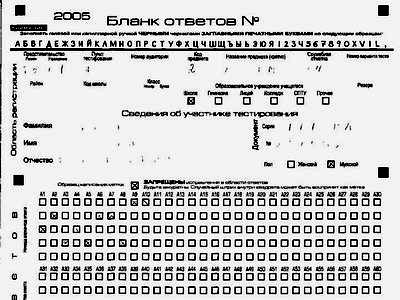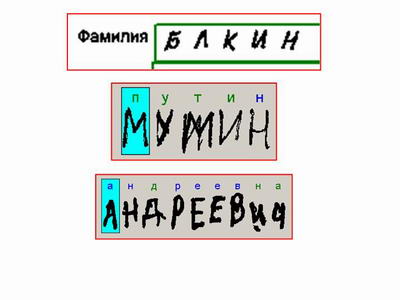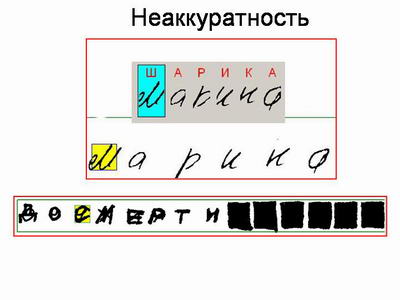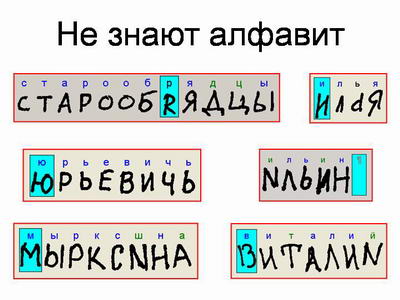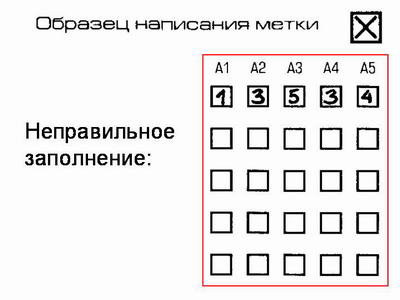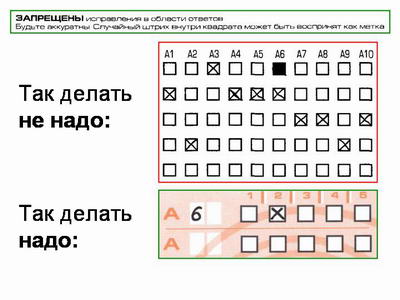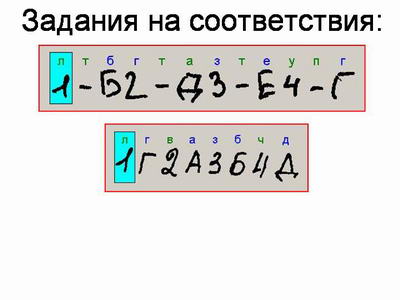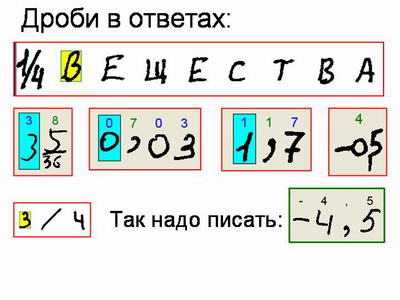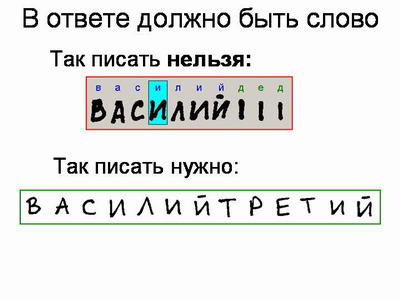The Ulyanovsk Regional Representative Office of the FCT illustrated the most common mistakes that are made when filling out Unified State Exam answer forms and gave recommendations for eliminating them
Let us remind you that the processing of Unified State Exam answer forms is carried out on computers. The forms are scanned, the inscriptions and marks on them are recognized, converted into a “digital” format and automatically checked. This technology allows you to process a huge number of forms in limited time, but requires testing participants to follow some simple rules. We will illustrate all errors with real images from the answer forms, which clearly show what is written on the answer form and what is recognized by the computer. Some people don't believe this happens. So let's begin:
|
Description of the error |
Image illustrating the error |
What to do, |
| 1. The registration area is completed, but the marks for Part A and the answers for Part B are not included in the answer form. | Firstly, you need to be more careful. Secondly, you should calculate your time so that you have time to fill out the answer form. Usually this is left for 15-30 minutes. |
|
| 2. The form is filled out with a blue pen or pencil. Nothing is visible in the image that got into the computer. |
|
|
| 3. The form is filled out with a blue pen. The image entered into the computer will not be read correctly. |
|
Unified State Exam forms must be filled out with a BLACK GEL PEN. The pen should leave a clear (not greasy) mark without glare. Bring 2 good black gel pens to the exam. |
| 4. The form is not filled in according to the pattern of writing characters. |
|
At the top of the answer form it is indicated how letters, numbers and other valid characters should be written so that they are successfully recognized. |
| 5. Again, the form is not filled out according to the patterns of writing characters printed at the top of the form. |
|
Would you like to receive a certificate or certificate with names like those in the picture? :) |
| 6. Carelessness |
|
Take your time! Please fill it out carefully. |
| 7. Filled out sloppily - it’s funny! |
|
Fill out the forms carefully according to the examples of writing characters. It is unlikely that such answers will be counted as correct. |
| 8. The answer sheet is your document. Is it possible to be so careless with your documents?! |
|
Fill out carefully. |
| 9. People have problems with the alphabet. |
|
If you don't know how to write some letters, look at the top of your answer sheet. There you will find all the letters of the Russian alphabet and numbers. An amazing situation, but it happens often. |
| 10. The answers in part A are filled in incorrectly. In this case, the computer “will assume” that the first answer option has been given for tasks A1-A5. |
|
The answer area for Part A tasks consists of a horizontal row of test task numbers. Under each task number there is a vertical column of four cells. In order to mark the answer that the test taker considers correct, under the task number he must put a mark (X) in the box whose number corresponds to the number of the answer he has chosen. A sample label entry is provided on the answer form. |
| 11. Unsuccessful attempt to undo the wrong label. As an answer to task A6, the computer will simultaneously receive answer options 1 and 2 |
|
Any mark (a cross, a line, even a dot) in the boxes for answers to part A is recognized as an answer, so coloring will not cancel the incorrectly chosen answer option. To replace an erroneous answer in part A, there is a special area in the form. The number of the test task is written in the field of two windows, and next to it (in the squares) you should indicate the correct (corrected) answer to the task. |
| 12. Inattention when reading the instructions for tasks in Part B. If the instructions for a test or task say that only a number can be the answer, then only a number can be written down as the answer to this task. All letters are recognized as numbers because the computer "expects" only numbers in these fields. This is an example from mathematics. |
|
Carefully read the instructions for the test, for individual parts (A, B, C) of the test and for the tasks. The instructions indicate what should be indicated as an answer to the task(s). |
| 13. Answers to tasks in part B were written in words when a number was required. This, by the way, is also an example from mathematics. |
|
If it is not specifically stated that the number should be written in words, then it should be written “in our native Arabic numerals.” Again, read the test instructions. |
| 14. The opposite example, when it was necessary to write down a set of letters, the letters were written mixed with numbers. Subject: history of Russia. |
|
The instructions for the task said: “the resulting sequence of LETTERS without any other characters or commas transfer to the answer form." |
| 15. The answer form contains extraneous characters that will “spoil” your possibly correct answer. |
|
There is no need to write extraneous characters on the answer sheet. If the answer must be a number, then only the number needs to be written down! No one is interested in the progress of the solution to tasks in parts A and B. |
| 16. Answers to tasks are “screwed up”, excuse the expression. |
|
Is it really difficult to calculate, for example, “four roots of three” and write it down as required in the instructions for the assignment?! Maybe you need to round to whole numbers, maybe to tenths and write the resulting number on your answer sheet. Again, carefully read the instructions in the test. |
| 17. On the left again in field B they write whatever they want. And on the right in fields B they are trying to write ordinary fractions, which is unacceptable. |
|
Read the instructions in the test. Each number, letter, minus sign (if the number is negative) or comma is written in a separate window, strictly according to the model from the top of the form. It is prohibited to write the answer in the form of a mathematical expression or formula. |
| 18. Unsuccessful attempts to write common fractions as answers to part B. Incorrect spelling of commas in answers. |
|
Ordinary fractions are not allowed in answers to questions in Part B. Each character is recorded in a separate window. It is best to write a comma in the lower third of the box. |
| 19. Units of measurement are written down, which is strictly unacceptable. |
|
It is unacceptable to write the names of units of measurement (degrees, percentages, meters, tons, etc.) after the number. Whoever determines what is written in the last example in field B2 “100 meters” or “10 ohms” will win a prize. |
| 20. In the history answer, the serial number of the monarch is written as a number, moreover, a Roman one. |
|
The instructions for the test state that “the names of monarchs should be written only in letters, for example “NICHOLAYVII.” Moreover, the instructions may also require writing down the century in words, for example, “eighteenth.” Read the instructions carefully. |
| 21. Spelling errors in answers. |
|
Learn not only terms, but also their correct spelling. It’s a shame to write “DIMITRIYDONTSOY” instead of “DMITRYDONSKAYA”. It would be a shame to miss a point for an “almost correct answer.” |
| 22. Spelling errors in answers. |
|
The same. Let's laugh. |
| 23. It’s not clear to a person what people were trying to write! What can you expect from a computer? |
|
Take your time filling out field B. If there is an error in field B, then Unified State Exam forms it is possible to correct it. In the area provided for this, in a field of two windows, the number of the test task is written down, and next to it (in the boxes) you should write the correct (corrected) answer to the task. |
| 24. The free form answer sheet (Part C) was used as a draft for solving parts A and B of the test. |
|
Use the forms as intended. |
| 25. Form C is filled out very sloppily. |
|
As you know, forms C for the Unified State Exam are checked by experts. Experts are people. Solutions to problems in Part C must be written down carefully so that your solution can be read and understood by another person. The expert has limited time to read your work, and if the expert spends all the time analyzing your “scribbles,” then the expert will not have enough time to give a good grade. Respect the work of experts! |
| 26. An excellent, absolutely correct solution, but the graph is drawn in pencil and after the work is scanned, the inscriptions NOT made with a black gel pen will disappear. THE EXPERT WILL NOT SEE THE GRAPHICS! In the image on the right is a photo of the form, on the left is what came out after scanning. |
|
Unified State Exam forms must be filled out with a BLACK GEL PEN. The pen should leave a clear (not greasy) mark without glare. |
| 27. Answer form No. 2 is filled out with a blue pen. After scanning your work (and let us remind you, experts receive scanned copies of your work for verification), it will be very difficult, and sometimes impossible, for the expert to read what you wrote. |
|
Unified State Exam forms must be filled out with a BLACK GEL PEN. Including Answer Form No. 2. The pen should leave a clear (not greasy) mark without glare. Bring 2 good black gel pens to the exam. |
This concludes our story about the mistakes of test participants. The article discussed only typical mistakes that are repeated in every exam. There are also individual ones (they abbreviate words, confuse fields, cannot find the number and series in their document, write first and patronymic names with errors, etc.) that cannot be systematized. But most mistakes can be avoided if:
- before going to the exam, read and understand the rules of participation in the Unified State Exam;
- during testing, read the instructions for the test that you received, and during the test, carefully read the instructions for individual tasks, if any;
- during testing, be attentive and collected, focus on completing the test.
It is recommended that before the real exam, you try to go through a similar testing procedure in the Unified State Exam mode in order to identify and evaluate the negative factors that you may encounter during one of the most important exams in your life.
We really hope that after reading this article you will not make such stupid and annoying mistakes. This will make it better for you and easier for us. Good luck with exams!
Prepared by RCIO of the Ulyanovsk region.
The form is filled in with a non-black gel pen

After processing (scanning) the form, the inscriptions made with a regular blue pen are not clearly visible. Inscriptions made in pencil are not visible at all.
The pen should leave a clear (not greasy) mark without gaps. This rule also applies to answer form No. 2, in which solutions to part C assignments are written.
The form is not filled in according to the pattern of writing characters.

At the top of the registration form and answer form No. 1, it is indicated how to write letters, numbers and other acceptable characters. If a Unified State Examination participant neglects the sample, the computer may incorrectly recognize what is written.
The form is filled out sloppily
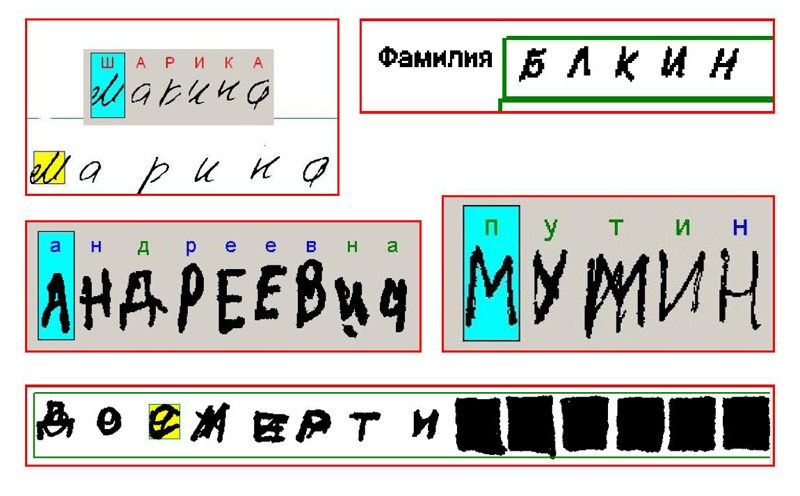
Inaccurately filled fields may also not be recognized correctly.
Incorrect notation of fractions in answers
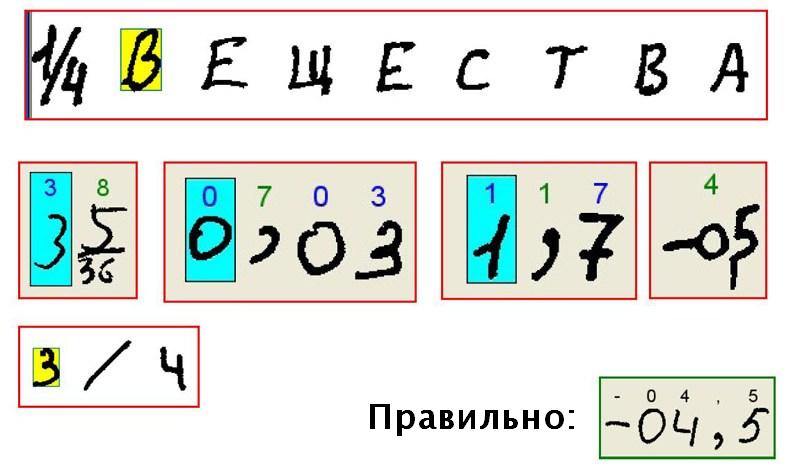
Recording decimal fractions in answer forms No. 1 is unacceptable. Each decimal symbol must be written in a separate box. It is best to write a comma in the lower third of the window.
Writing units of measurement in answers

In answer forms No. 1 it is also unacceptable to write units of measurement after the number (percents, meters, degrees, grams, etc.).
Incorrect recording of monarchs' names

The serial numbers of the monarchs in answer form No. 1 should be written only in words without spaces. For example, “BASILIY THE 3rd”, “PETER THE 1st”. The same applies to the recording of centuries (“SIXTEENTH” instead of “XVI”).
Using the form for other purposes

Some USE participants use form No. 2 (for part C) as a draft for solving part A or B.
Exiting the fields of the answer form No. 2

Entries in answer form No. 2 should not go beyond the bounding limits. After scanning, any text outside the frame will be lost. The expert checking the answers to Part C receives the scanned copies. If a USE participant does not comply with this rule, his work will be difficult to read and correctly evaluate.
Using a proofreader to correct errors

According to the rules for filling out Unified State Examination forms, the use of a corrector (“putty”, “stroke”) is not allowed. Moreover, the proofreader is not included in the list of items permitted for use in the exam. To replace one answer option with another in Part A or B, you must use a special area of the form.
Particles of the corrector may fall off when scanning the work. This will not only lead to a significant slowdown in the processing of forms, but will also spoil all subsequent forms with a line, as indicated in the figure. All cells through which this line has passed will be recognized as the selected answer.
When using material on another site, you must
Why do you need to fill out forms with a black gel pen?
 After processing (scanning) the form, the inscriptions made with a regular blue pen are not clearly visible. Inscriptions made in pencil are not visible at all. The pen should leave a clear (not greasy) mark without gaps. This rule also applies to answer form No. 2, in which solutions to part C assignments are written.
After processing (scanning) the form, the inscriptions made with a regular blue pen are not clearly visible. Inscriptions made in pencil are not visible at all. The pen should leave a clear (not greasy) mark without gaps. This rule also applies to answer form No. 2, in which solutions to part C assignments are written.
Why do you need to fill out forms strictly according to the sample?

At the top of the registration form and answer form No. 1, it is indicated how to write letters, numbers and other acceptable characters. If a Unified State Examination participant neglects the sample, the computer may incorrectly recognize what is written.
What can result from carelessness when filling out the form? 
Inaccurately filled fields may also not be recognized correctly.
How to correctly write fractions on the answer sheet?

Recording decimal fractions in answer forms No. 1 is unacceptable. Each decimal symbol must be written in a separate box. It is best to write a comma in the lower third of the window.
How do I record measurements in answers?

In answer forms No. 1 it is also unacceptable to write units of measurement after the number (percents, meters, degrees, grams, etc.).
How to write the names of monarchs? 
The serial numbers of the monarchs in answer form No. 1 should be written only in words without spaces. For example, “BASILIY THE 3rd”, “PETER THE 1st”. The same applies to the recording of centuries (“SIXTEENTH” instead of “XVI”).
Using the form for other purposes

Some USE participants use form No. 2 (for part C) as a draft for solving part A or B.
Exiting the fields of the answer form No. 2 
Entries in answer form No. 2 should not go beyond the bounding limits. After scanning, any text outside the frame will be lost. The expert checking the answers to Part C receives the scanned copies. If a USE participant does not comply with this rule, his work will be difficult to read and correctly evaluate.
Why can't you use a proofreader to correct mistakes?

According to the rules for filling out Unified State Examination forms, the use of a corrector (“putty”, “stroke”) is not allowed. Moreover, the proofreader is not included in the list of items permitted for use in the exam. To replace one answer option with another in Part A or B, you must use a special area of the form. Particles of the corrector may fall off when scanning the work. This will not only lead to a significant slowdown in the processing of forms, but will also spoil all subsequent forms with a line, as indicated in the figure. All cells through which this line has passed will be recognized as the selected answer.
The form is filled in with a non-black gel pen

After processing (scanning) the form, the inscriptions made with a regular blue pen are not clearly visible. Inscriptions made in pencil are not visible at all.
The pen should leave a clear (not greasy) mark without gaps. This rule also applies to answer form No. 2, in which solutions to part C assignments are written.
The form is not filled in according to the pattern of writing characters.

At the top of the registration form and answer form No. 1, it is indicated how to write letters, numbers and other acceptable characters. If a Unified State Examination participant neglects the sample, the computer may incorrectly recognize what is written.
The form is filled out sloppily

Inaccurately filled fields may also not be recognized correctly.
Incorrect notation of fractions in answers

Recording decimal fractions in answer forms No. 1 is unacceptable. Each decimal symbol must be written in a separate box. It is best to write a comma in the lower third of the window.
Writing units of measurement in answers

In answer forms No. 1 it is also unacceptable to write units of measurement after the number (percents, meters, degrees, grams, etc.).
Incorrect recording of monarchs' names

The serial numbers of the monarchs in answer form No. 1 should be written only in words without spaces. For example, “BASILIY THE 3rd”, “PETER THE 1st”. The same applies to the recording of centuries (“SIXTEENTH” instead of “XVI”).
Using the form for other purposes

Some USE participants use form No. 2 (for part C) as a draft for solving part A or B.
Exiting the fields of the answer form No. 2

Entries in answer form No. 2 should not go beyond the bounding limits. After scanning, any text outside the frame will be lost. The expert checking the answers to Part C receives the scanned copies. If a USE participant does not comply with this rule, his work will be difficult to read and correctly evaluate.
Using a proofreader to correct errors

According to the rules for filling out Unified State Examination forms, the use of a corrector (“putty”, “stroke”) is not allowed. Moreover, the proofreader is not included in the list of items permitted for use in the exam. To replace one answer option with another in Part A or B, you must use a special area of the form.
Particles of the corrector may fall off when scanning the work. This will not only lead to a significant slowdown in the processing of forms, but will also ruin all subsequent forms

